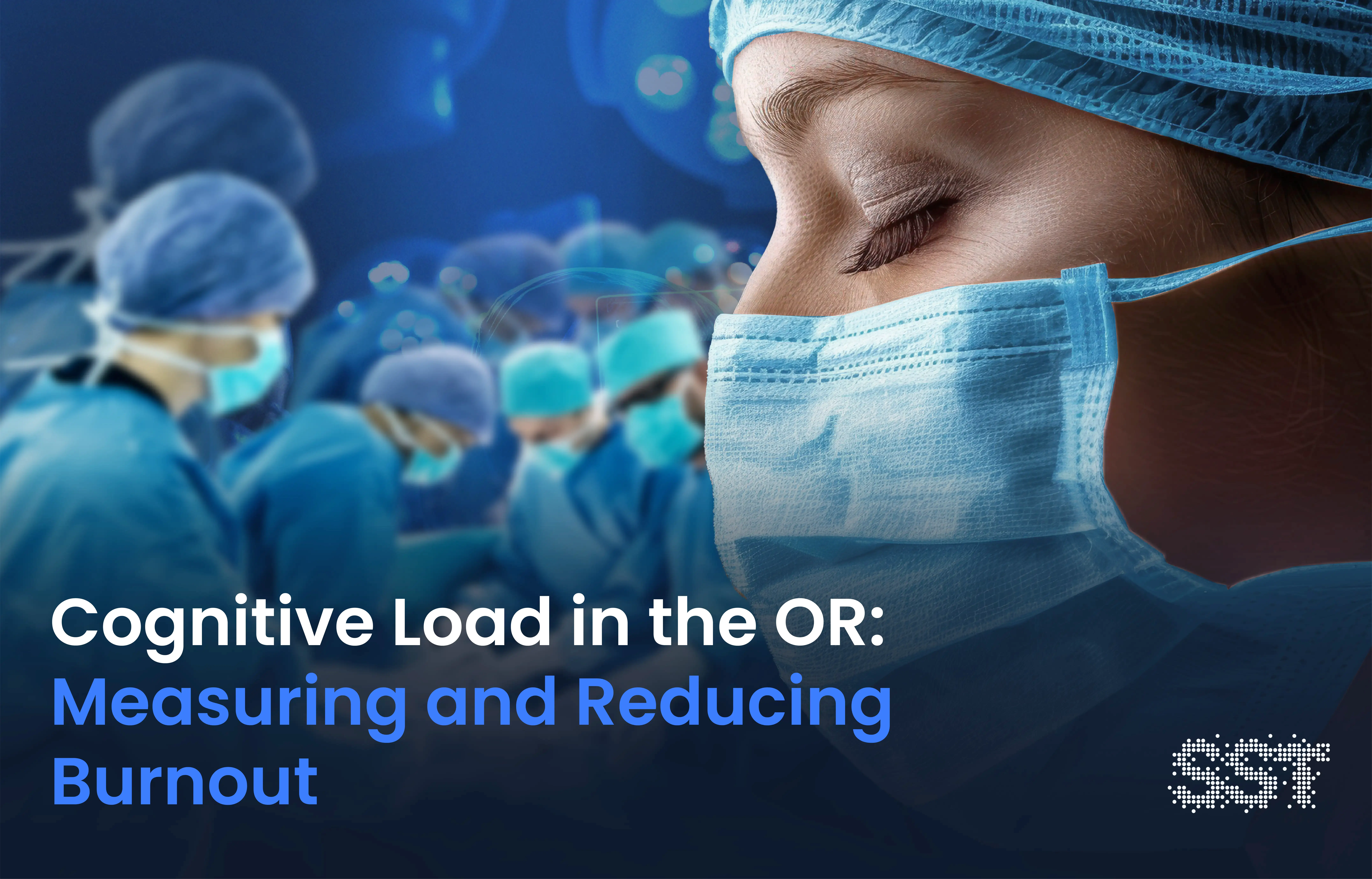CLINICIAN WELL-BEING
Psychological Safety in Healthcare Teams: From the OR Front Lines to Executive Strategy
Discover why psychological safety in healthcare must be embedded in the OR and sustained by leadership from the top down.
Sep 25, 2025
Surgical Safety Technologies
Speaking up in the operating room (OR) can save lives, but only if people feel safe enough to do so. Psychological safety, the belief that one can speak up, take risks, and admit mistakes without fear of punishment, is the foundation of effective teamwork in healthcare. Psychological safety in healthcare teams must be embedded from the ground up—beginning with high-stakes environments like the OR and sustained by deliberate leadership from the C-suite.
Why Psychological Safety in Healthcare Teams Matters
In surgical settings, psychological safety can mean the difference between life and death. The consequences of poor psychological safety manifest in preventable clinical errors that ripple far beyond the OR. For example:
The circulating nurse observes a surgeon's sleeve brush against a non-sterile surface during the procedure, but the surgeon continues operating without acknowledging the contamination. Speaking up means stopping the surgery to re-gown and re-glove, delaying subsequent cases and potentially leading to overtime and the need to reschedule late-day cases.
A surgical technologist thinks there might be an instrument count discrepancy but hesitates to voice their concern because the count responsibility is primarily that of the surgical nurse—leading to reoperation, infection, or worse.
A resident anesthesiologist makes several attempts to perform a challenging intubation while oxygen saturation drops, but junior staff hesitate to call for help as they fear future prejudice or retaliation fallout. The patient experiences cardiac instability, the surgery is cancelled and rescheduled at a later date.
Research demonstrates these aren't isolated incidents. The gap between observation and action directly correlates with psychological safety levels,¹ making the difference between routine care and preventable patient harm.
Creating psychological safety in healthcare² improves collaboration, especially in high pressure scenarios. Teams that feel safe to voice concerns and share observations collaborate more effectively, leading to better outcomes. Strong psychological safety also reduces burnout and improves employee retention. High-reliability organizations recognize this as a cornerstone of patient safety and team performance.
The OR: The Frontline of Psychological Safety
Psychological safety in the OR is not theoretical—it’s measured in seconds. When a nurse notices the surgeon's glove tear during a critical procedure, or when an anesthesiologist's drug calculation seems off, the window for speaking up closes rapidly. These moments reveal whether or not a team truly operates with psychological safety.
The OR serves as the ultimate testing ground for psychological safety in healthcare. Here, the stakes are highest, hierarchies are steepest, and time is shortest. It's where psychological safety reveals its true nature, not as a nice-to-have cultural ideal, but as a life-or-death operational necessity.
High-Pressure Dynamics
Surgical teams operate within a perfect storm of psychological barriers. The rapid room turnover expectation between cases leaves little room for reflective communication that builds trust. Masked faces and sterile barriers already limit communication, and hierarchical obstacles compound this isolation further.
The brain's threat detection system activates when under stress, making it neurologically harder to speak up. And hierarchy triggers our brain's social threat response, which raises cortisol levels that impact both decision-making and the willingness to challenge authority—even when patient safety hangs in the balance.
Non-verbal cues become amplified in these environments. An eye roll, dismissive gesture, or interruption can shut down communication for the remainder of the procedure. Team members quickly learn to read these signals, often adjusting their behavior to avoid triggering negative responses rather than focusing on optimal patient care.
Barriers to Speaking Up
The traditional OR hierarchy creates multiple layers of psychological barriers that extend far beyond simple power distance:
Professional identity conflicts: A surgical technologist who spots a sterility breach faces the dual burden of challenging both medical authority and their own scope boundaries. They must simultaneously question a physician's actions while potentially stepping outside their defined role—a double violation that amplifies the psychological risk of speaking up.
Previous negative experiences: Research demonstrates that one dismissive response to a safety concern can silence that team member³ for months. Healthcare workers develop sophisticated internal risk-benefit calculations, weighing patient safety against their own professional survival.
Cognitive biases under stress: In high-stakes moments, confirmation bias leads teams to interpret ambiguous situations as "probably fine" rather than risk being wrong. The psychological comfort of assuming competence outweighs the discomfort of potential confrontation.
Individual professional stakes: The consequences of speaking up extend beyond the immediate patient to frontline staff’s own professional survival. A surgical tech questioning a count faces potential retaliation that could affect future case assignments, peer relationships, performance reviews, and day-to-day work environment.
The Hidden Costs of Psychological Silence
The consequences of a break down in OR team psychological safety ripple far beyond the immediate procedure:
Cognitive load increases as team members spend mental energy managing fear rather than focusing on patient care
Learning stops as mistakes are hidden rather than discussed, preventing system-wide improvement
Staff turnover accelerates as high-performing talent leaves teams where their expertise isn't valued
Defensive medicine increases as providers order unnecessary tests and procedures to protect themselves rather than optimize patient outcomes
Real-Time Adaptation Under Pressure
Advanced observational tools, like the OR Black Box®, reveal the stark behavioral differences between psychologically safe and unsafe teams. A study in the Annals of Surgery⁴ used the OR Black Box to examine how surgical teams respond to unexpected challenges. Teams with stronger psychological safety demonstrated greater adaptability, better communication, and faster problem-solving under uncertainty. They adjusted roles fluidly, shared observations openly, and made collective decisions—showcasing the direct, observable impact of a safe team culture.
When Safety Is Faked on Paper
One of the most telling examples of how psychological safety affects behavior comes from a study comparing EMR documentation of safety checklists with actual behavior⁵ observed via video.
In gynecological surgeries, surgical safety checklist items were often marked as “complete” in electronic records—even when they weren’t actually verbalized or confirmed in practice. This disconnect was particularly common in environments where team members didn’t feel safe to speak up or challenge procedural shortcuts.
A 2024 cross-sectional survey⁶ reinforced these findings, demonstrating that staff perception of psychological safety directly influenced engagement with the WHO Surgical Safety Checklist. When psychological safety was high, teams were more likely to treat the checklist as a meaningful tool rather than a bureaucratic task. In contrast, low psychological safety led to more superficial or rushed use, reducing its effectiveness.
The Ripple Effect: How OR Culture Sets the Tone
The safety culture in the OR reflects and reinforces that of the broader hospital system. Behaviors that demonstrate and welcome speaking up in the OR spread to the post-anesthesia care unit (PACU), intensive care units (ICUs), emergency departments (EDs), and inpatient care areas.
Senior surgeons and attending physicians set the tone for what is acceptable. When they model respectful listening, acknowledge uncertainty, and invite questions, junior staff are more likely to do the same. Over time, this builds a culture of psychological safety that extends beyond the OR.
Small cultural shifts in the OR can lead to meaningful change across the hospital. Practices like active listening, collaborative debriefings, and shared decision-making often begin in high-stakes areas, then gradually become standard in other departments.
The C-Suite’s Strategic Role in Building Psychological Safety in Healthcare Teams
Psychological safety doesn’t sustain itself. It requires strategic reinforcement from executive leadership. The C-suite plays a critical role in allocating resources, setting institutional values, and holding the entire health system accountable for safety culture.
Leaders must actively promote transparency and open communication. This includes creating channels for staff to speak up, even when it’s uncomfortable. Investing in leadership development helps mid-level and frontline leaders build the skills they need to foster safety in their teams.
Executive leaders should encourage upward feedback and ensure that whistleblower protections are both available and trusted. When staff know their voices will be heard without retaliation, they are more likely to use them.
Data can help leadership teams guide their efforts. Regular safety culture assessments, staff surveys, and case video reviews offer actionable insights. These tools make it easier to identify culture gaps and measure the impact of interventions over time.
Download our fact sheet, AI in Healthcare: Maintaining Psychological Safety,⁷ for leadership strategies to strengthen psychological safety.
Bridging the Gap: Aligning Frontline Realities with Executive Strategy
For psychological safety to thrive, executive intent must align with frontline reality. Safety checklists, communication protocols, and team training are only effective if staff feel safe using them. That sense of safety is shaped by leadership decisions around time, staffing, and support.
Frontline teams can’t build psychological safety in healthcare⁸ alone. They need time to debrief, resources for training, and the confidence that speaking up won’t backfire. These factors are all within leadership’s control.
Systems must also enable upward communication. Anonymous reporting tools, interdisciplinary safety huddles, and direct feedback channels between OR staff and executive teams are essential. Grand rounds that showcase both successes and failures in psychological safety can reinforce learning across the organization.
It’s also critical for clinical leaders to participate in these conversations. Their presence sends a message that safety is a shared priority. Behind the scenes, they must empower their teams to voice concerns and participate in improvement efforts.
Strategic planning should include operational voices. OR leaders—such as nurse managers, anesthesiologists, and surgeons—offer insight that can shape realistic and effective policies. Involving them directly promotes shared ownership of safety initiatives.
Finally, leadership behavior must reflect the culture they want to build. How executives respond to errors, reward learning, and handle dissent sends powerful signals. Sustainable culture depends on this visible, consistent engagement.
If you’re interested in learning how your organization can increase psychological safety from the OR to the C-suite, book a demo with us.
Recommended Reading
Bahadurzada, H., Kerrissey, M., & Edmondson, A.C. (2024). Speaking Up and Taking Action: Psychological Safety and Joint Problem-Solving Orientation in Safety Improvement. Healthcare;12(8), 812. https://doi.org/10.3390/healthcare12080812
Surgical Safety Technologies. (2025, July 30). Creating Psychological Safety in Healthcare to Drive Performance, Retention, and Resilience [blog post]. https://www.surgicalsafety.com/blog/creating-psychological-safety-in-healthcare
Lainidi, O., Jendeby, M.K., Montgomery, A., et., al. (2023). An integrative systematic review of employee silence and voice in healthcare: what are we really measuring? Front Psychiatry;14, 1111579. https://www.doi.org/10.3389/fpsyt.2023.1111579
Møller K.E., McLeskey, O.W., Rosthøj, S., et., al. (2024). Healthcare Professionals’ perception of the World Health Organization Surgical Safety Checklist and psychological safety: a cross-sectional survey. BMJ Open Qual;13(4). https://pubmed.ncbi.nlm.nih.gov/39653512/
Incze, T., Pinkney, S.J., Li, C., et., al. (2024). Using the Operating Room Black Box to Assess Surgical Team Member Adaptation Under Uncertainty: An Observational Study. Annals of Surgery;280(1),75-81. https://journals.lww.com/annalsofsurgery/fulltext/2024/07000/using_the_operating_room_black_box_to_assess.13.aspx
Møller K.E., Sørensen, J.L., Rosthøj, S., et., al. (2025). Does the Surgical Safety Checklist need a co-pilot? Comparing adherence in gynecological surgery through electronic medical records and OR Black Box video observations. Surg Endosc; https://doi.org/10.1007/s00464-025-11966-0
Surgical Safety Technologies. (2025). AI in Healthcare: Maintaining Psychological Safety [fact sheet]. www.surgicalsafety.com/resources/ai-in-healthcare-maintaining-psychological-safety
Surgical Safety Technologies. (2025, May 8). Psychological Safety in Healthcare Drives High-Performance Teams - and AI Should Support It [blog post]. https://www.surgicalsafety.com/blog/psychological-safety-in-healthcare-ai-should-support-it







